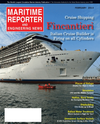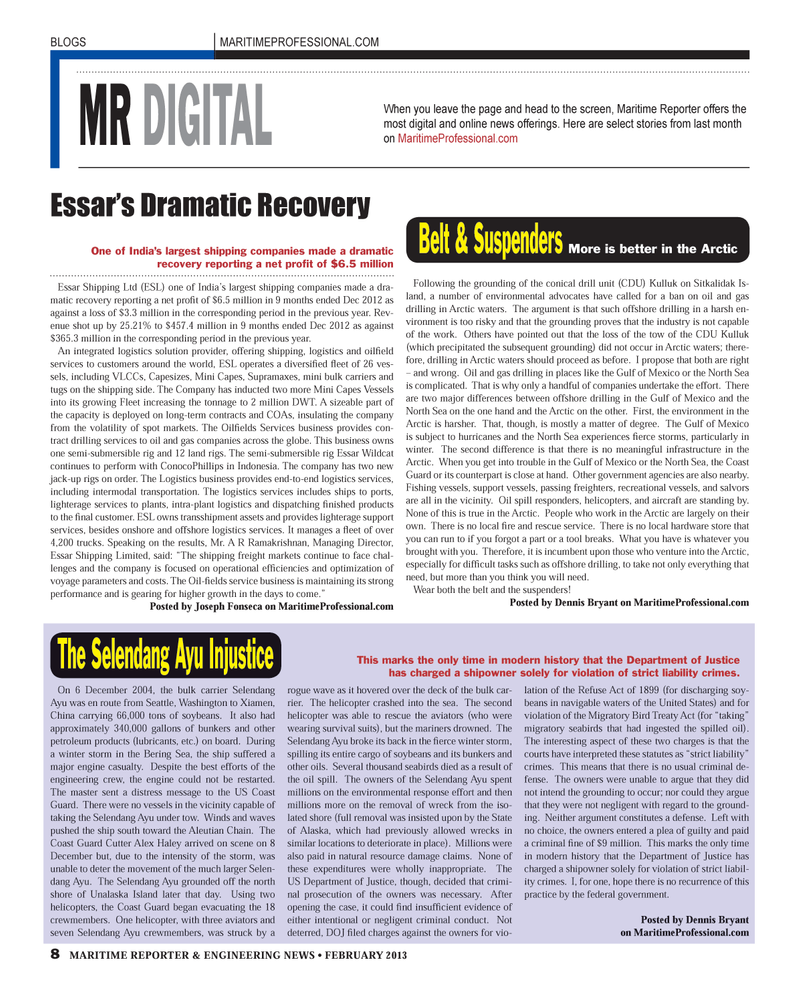
Page 8: of Maritime Reporter Magazine (February 2013)
Cruise & Passenger Vessel
Read this page in Pdf, Flash or Html5 edition of February 2013 Maritime Reporter Magazine
8 MARITIME REPORTER & ENGINEERING NEWS ? FEBRUARY 2013 On 6 December 2004, the bulk carrier Selendang Ayu was en route from Seattle, Washington to Xiamen, China carrying 66,000 tons of soybeans. It also had approximately 340,000 gallons of bunkers and other petroleum products (lubricants, etc.) on board. During a winter storm in the Bering Sea, the ship suffered a major engine casualty. Despite the best efforts of the engineering crew, the engine could not be restarted. The master sent a distress message to the US Coast Guard. There were no vessels in the vicinity capable of taking the Selendang Ayu under tow. Winds and waves pushed the ship south toward the Aleutian Chain. The Coast Guard Cutter Alex Haley arrived on scene on 8 December but, due to the intensity of the storm, was unable to deter the movement of the much larger Selen- dang Ayu. The Selendang Ayu grounded off the north shore of Unalaska Island later that day. Using two helicopters, the Coast Guard began evacuating the 18 crewmembers. One helicopter, with three aviators and seven Selendang Ayu crewmembers, was struck by a rogue wave as it hovered over the deck of the bulk car- rier. The helicopter crashed into the sea. The second helicopter was able to rescue the aviators (who were wearing survival suits), but the mariners drowned. The Selendang Ayu broke its back in the Þ erce winter storm, spilling its entire cargo of soybeans and its bunkers and other oils. Several thousand seabirds died as a result of the oil spill. The owners of the Selendang Ayu spent millions on the environmental response effort and then millions more on the removal of wreck from the iso-lated shore (full removal was insisted upon by the State of Alaska, which had previously allowed wrecks in similar locations to deteriorate in place). Millions were also paid in natural resource damage claims. None of these expenditures were wholly inappropriate. The US Department of Justice, though, decided that crimi-nal prosecution of the owners was necessary. After opening the case, it could Þ nd insuf Þ cient evidence of either intentional or negligent criminal conduct. Not deterred, DOJ Þ led charges against the owners for vio- lation of the Refuse Act of 1899 (for discharging soy- beans in navigable waters of the United States) and for violation of the Migratory Bird Treaty Act (for ?taking? migratory seabirds that had ingested the spilled oil). The interesting aspect of these two charges is that the courts have interpreted these statutes as ?strict liability? crimes. This means that there is no usual criminal de- fense. The owners were unable to argue that they did not intend the grounding to occur; nor could they argue that they were not negligent with regard to the ground-ing. Neither argument constitutes a defense. Left with no choice, the owners entered a plea of guilty and paid a criminal Þ ne of $9 million. This marks the only time in modern history that the Department of Justice has charged a shipowner solely for violation of strict liabil- ity crimes. I, for one, hope there is no recurrence of this practice by the federal government. Posted by Dennis Bryant on MaritimeProfessional.com BLOGSMARITIMEPROFESSIONAL.COMMR DIGITAL When you leave the page and head to the screen, Maritime Reporter offers the most digital and online news offerings. Here are select stories from last month on MaritimeProfessional.comBelt & Suspenders More is better in the Arctic Essar?s Dramatic Recovery One of India?s largest shipping companies made a dramatic recovery reporting a net pro t of $6.5 million Essar Shipping Ltd (ESL) one of India?s largest shipping companies made a dra- matic recovery reporting a net proÞ t of $6.5 million in 9 months ended Dec 2012 as against a loss of $3.3 million in the corresponding period in the previous year. Rev- enue shot up by 25.21% to $457.4 million in 9 months ended Dec 2012 as against $365.3 million in the corresponding period in the previous year. An integrated logistics solution provider, offering shipping, logistics and oil Þ eld services to customers around the world, ESL operates a diversi Þ ed ß eet of 26 ves- sels, including VLCCs, Capesizes, Mini Capes, Supramaxes, mini bulk carriers and tugs on the shipping side. The Company has inducted two more Mini Capes Vessels into its growing Fleet increasing the tonnage to 2 million DWT. A sizeable part of the capacity is deployed on long-term contracts and COAs, insulating the company from the volatility of spot markets. The Oil Þ elds Services business provides con- tract drilling services to oil and gas companies across the globe. This business owns one semi-submersible rig and 12 land rigs. The semi-submersible rig Essar Wildcat continues to perform with ConocoPhillips in Indonesia. The company has two new jack-up rigs on order. The Logistics business provides end-to-end logistics services, including intermodal transportation. The logistics services includes ships to ports, lighterage services to plants, intra-plant logistics and dispatching Þ nished products to the Þ nal customer. ESL owns transshipment assets and provides lighterage support services, besides onshore and offshore logistics services. It manages a ß eet of over 4,200 trucks. Speaking on the results, Mr. A R Ramakrishnan, Managing Director, Essar Shipping Limited, said: ?The shipping freight markets continue to face chal-lenges and the company is focused on operational efÞ ciencies and optimization of voyage parameters and costs. The Oil- Þ elds service business is maintaining its strong performance and is gearing for higher growth in the days to come.? Posted by Joseph Fonseca on MaritimeProfessional.com Following the grounding of the conical drill unit (CDU) Kulluk on Sitkalidak Is-land, a number of environmental advocates have called for a ban on oil and gas drilling in Arctic waters. The argument is that such offshore drilling in a harsh en- vironment is too risky and that the grounding proves that the industry is not capable of the work. Others have pointed out that the loss of the tow of the CDU Kulluk (which precipitated the subsequent grounding) did not occur in Arctic waters; there- fore, drilling in Arctic waters should proceed as before. I propose that both are right ? and wrong. Oil and gas drilling in places like the Gulf of Mexico or the North Sea is complicated. That is why only a handful of companies undertake the effort. There are two major differences between offshore drilling in the Gulf of Mexico and the North Sea on the one hand and the Arctic on the other. First, the environment in the Arctic is harsher. That, though, is mostly a matter of degree. The Gulf of Mexico is subject to hurricanes and the North Sea experiences Þ erce storms, particularly in winter. The second difference is that there is no meaningful infrastructure in the Arctic. When you get into trouble in the Gulf of Mexico or the North Sea, the Coast Guard or its counterpart is close at hand. Other government agencies are also nearby. Fishing vessels, support vessels, passing freighters, recreational vessels, and salvors are all in the vicinity. Oil spill responders, helicopters, and aircraft are standing by. None of this is true in the Arctic. People who work in the Arctic are largely on their own. There is no local Þ re and rescue service. There is no local hardware store that you can run to if you forgot a part or a tool breaks. What you have is whatever you brought with you. Therefore, it is incumbent upon those who venture into the Arctic, especially for difÞ cult tasks such as offshore drilling, to take not only everything that need, but more than you think you will need. Wear both the belt and the suspenders! Posted by Dennis Bryant on MaritimeProfessional.com The Selendang Ayu Injustice This marks the only time in modern history that the Department of Justice has charged a shipowner solely for violation of strict liability crimes. MR #2 (1-9).indd 8MR #2 (1-9).indd 82/4/2013 3:42:36 PM2/4/2013 3:42:36 PM

 7
7

 9
9
